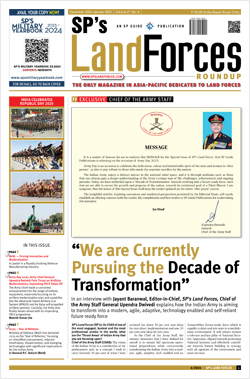INDIAN ARMED FORCES CHIEFS ON OUR RELENTLESS AND FOCUSED PUBLISHING EFFORTS

The insightful articles, inspiring narrations and analytical perspectives presented by the Editorial Team, establish an alluring connect with the reader. My compliments and best wishes to SP Guide Publications.

"Over the past 60 years, the growth of SP Guide Publications has mirrored the rising stature of Indian Navy. Its well-researched and informative magazines on Defence and Aerospace sector have served to shape an educated opinion of our military personnel, policy makers and the public alike. I wish SP's Publication team continued success, fair winds and following seas in all future endeavour!"

Since, its inception in 1964, SP Guide Publications has consistently demonstrated commitment to high-quality journalism in the aerospace and defence sectors, earning a well-deserved reputation as Asia's largest media house in this domain. I wish SP Guide Publications continued success in its pursuit of excellence.
- MoD initiates comprehensive review of Defence Acquisition Procedure 2020, pushes for defence reforms
- G7: The Swansong
- Kalinga Connect: South Asia to Polynesia
- Must Credit DRDO for Operation Sindoor, now what is next for defence R&D?
- The layered Air Defence systems that worked superbly, the key element of Operation Sindoor
- Operation Sindoor | Day 2 DGMOs Briefing
- Operation Sindoor: Resolute yet Restrained
Financing America's Wars
Decoding the nexus of global politics and economics with a look at the power of US Dollar, its role in modern day conflicts, and the shifting new world order
 |
The Author is former Chief of Staff of a frontline Corps in the North East and a former helicopter pilot. He earlier headed the China & neighbourhood desk at the Defence Intelligence Agency. He retired in July 2020 and held the appointment of Addl DG Information Systems at Army HQ. |
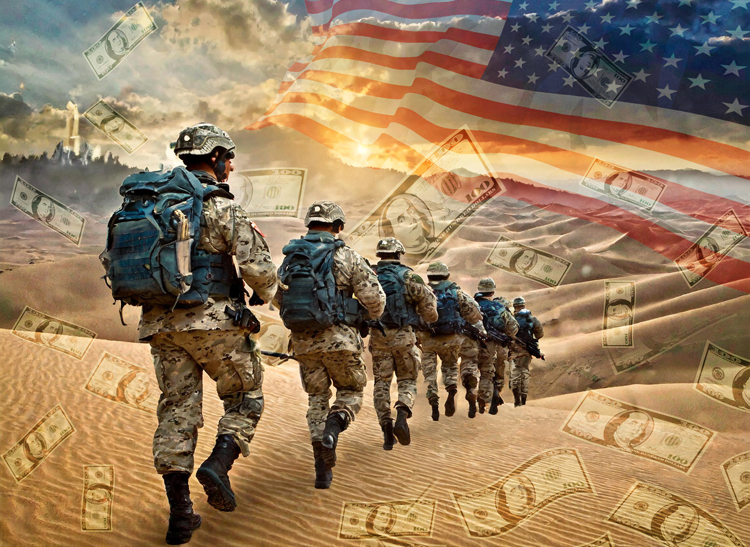
The end of WW II must have brought immense relief around the globe. Joyous crowds gathered to celebrate in the streets of Europe as news trickled in on May 8, 1945 that Nazi Germany had surrendered. Months later, on September 2, 1945, formal surrender documents were signed aboard the USS Missouri, designating the day as the official Victory over Japan (V-J) Day. There was accelerated de-colonisation bringing freedom to a vast populace across Asia and Africa. But what happened to peace?
The Emergence of Cold War
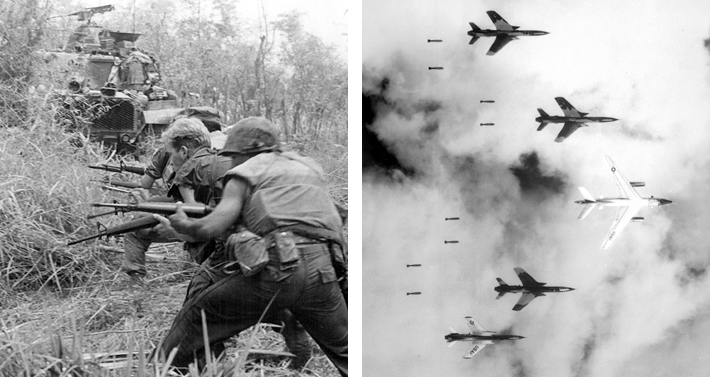
In the dying embers of WW II, an iron curtain descended across Europe from the Baltic to the Adriatic, ushering in the Cold War that framed the post-WW geo-political landscape. Even after the Berlin wall fell in 1989 and the Soviet Union collapsed dramatically in 1991, mutual suspicion and bitter rivalry between the collective west and the Soviet successor state Russia, continues to reverberate, lighting up war zones.
A Costs of War project at Brown University revealed that 20 years of post-9/11 wars have cost the US an estimated $8 trillion and have killed more than 9,00,000 people.
From Korea to Vietnam, from Africa to Latin America, the fear of Domino effect has been the operative lynchpin for the American deep state, a war-making machine that seems to have a life of its own. Terminologies have undergone change, reflective of the times. For example, the original Domino theory posits that if one country in a region came under the influence of communism, then the surrounding countries would follow. That was the rationale for America stepping into Vietnam after the French were comprehensively defeated in the battle of Dien Bin Fu in 1954.
Shifting Dynamics – from Communism to Dictatorship
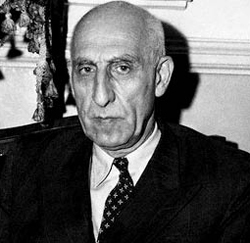
Former Prime Minister of Iran
The fear of communism spreading its tentacles has all but evaporated since 1991. So now it is about democracy versus dictatorship (more crudely, 'us' versus 'them', using the smokescreen of rule of law, pitting the collective west against an imaginary axis of evil). The world is expected to have collective amnesia about America's stellar track record of throwing out democratically elected leaders, whether it was Prime Minister Mohammad Mossadegh of Iran (1953) after he nationalised the Iranian oil industry to the detriment of Britain or President Salvador Allende of Chile (1973) who was killed by bombing his Presidential Palace for nationalising Chile's resources. By one count, the United States has interfered in more than 80 foreign elections between 1946 and 2000. And that doesn't count US-backed coups and invasions. American arms industries account for almost 60 per cent of total arms sales by the world's 100 largest defence contractors. The basic agenda of manufacturing enemies to wage wars has remained intact. Ukraine is the latest theatre playing out full steam, ten years after democratically elected President Yanukovych was overthrown in 2014.
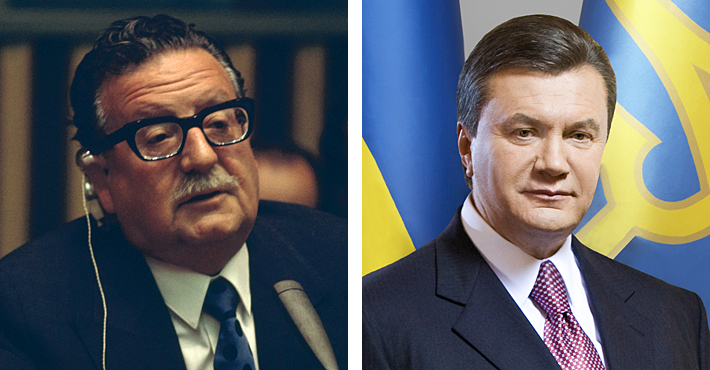
The answer may lie in understanding how the US has weaponised the US Dollar's status as the world's reserve currency to finance its unending wars without pinching its voracious consumeristic 'American Way of Life'.
Costs of War
Wars impose heavy financial and human toll. A Costs of War project at Brown University revealed that 20 years of post-9/11 wars have cost the US an estimated $8 trillion and have killed more than 9,00,000 people. It is another matter that Taliban is firmly back in the saddle in Afghanistan, and radical Islamic Jihadism is spreading its tentacles far beyond the Middle East and North Africa, into heartland Europe. Europe has been grappling with cost-of-living crisis and its growth engine Germany has technically slipped into recession. Yet the EU has bulldozed a 50 billion euros ($54 billion) in aid to Ukraine this year. The US national debt passed $33.99 trillion in January 2024. Yet it has extended over $75 billion in military and other aid to Ukraine and made a $106 billion supplemental war funding request on October 23, 2023 which is stuck in the US Congress. Do the US and the EU possess unlimited resources at their disposal to finance wars?


Dominance of the Dollar and the Challenges
The answer to this profound question may lie in understanding how the US has weaponised the US Dollar's status as world's reserve currency to finance its unending wars without pinching its voracious consumeristic 'American Way of Life'. The greenback was formally made the world's reserve currency in 1944 as a result of the Bretton Woods Agreement. President Richard Nixon abandoned the gold standard in 1971. From that point on, the dollar has been backed not by precious metal, but is basically a fiat currency. Since 1971, numerous people have called for the end of the US dollar as the world's reserve currency. The call only grew louder after the war in Ukraine when the US froze some $300 billion Russian assets held in western banks, imposed some 19,000 sanctions and ejected it from the SWIFT monetary settlement system.
Several factors have led to the dollar maintaining its international reserve currency status over seven decades. One is the so-called "petrodollar", in place since the 1973 deal with Saudi Arabia.
Several factors have led to the dollar maintaining its international reserve currency status over seven decades. One is the so-called "petrodollar", in place since the 1973 deal with Saudi Arabia. As the global oil trade amounts to billions of dollars per day and all countries need energy, this creates a great deal of demand for dollars to facilitate these transactions. In the last three years alone, the US Federal Reserve has simply printed over $14 trillion to keep its economy afloat and buy up goods and services from rest of the world. What if major oil producers decide to ditch the US Dollar and enter into bilateral arrangements or use other means to settle their transactions?
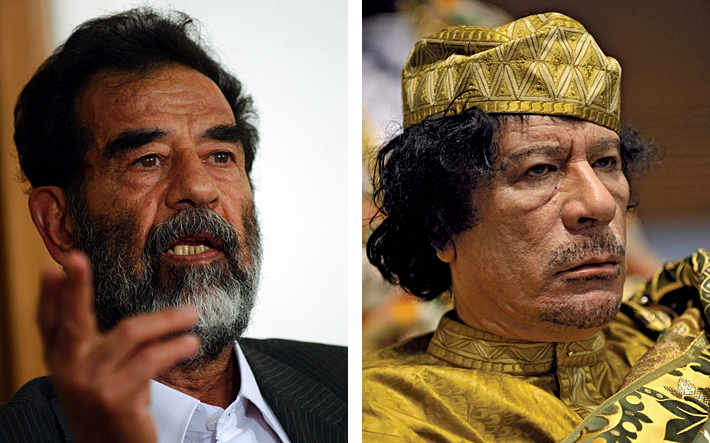
Saddam attempted it in October 2000 with Iraq dumping the US dollar for the more multilateral Euro. Iraq was savagely bombed in 2003 on the false pretext of possessing WMDs. Libya's Gaddafi intended to establish a pan-African currency based on the Libyan golden Dinarto provide the Francophone African Countries with an alternative to the French franc (CFA). Gaddafi was eliminated in 2011.
This year, the BRICS will enlarge with Saudi Arabia, Iran, UAE, Egypt, Ethiopia and Argentina joining. It has some of the largest producers and consumers of oil. A commodity backed BRICS currency is on the works.
It is playing out in the Ukraine war as well. The Nord Stream II pipeline, a Russo-German infrastructure project that took ten years and $10 billion to build, has been sabotaged, snapping clean and cheap natural gas from flowing to European homes and factories. This ecosystem jeopardised America's Petro-dollar energy hegemony.
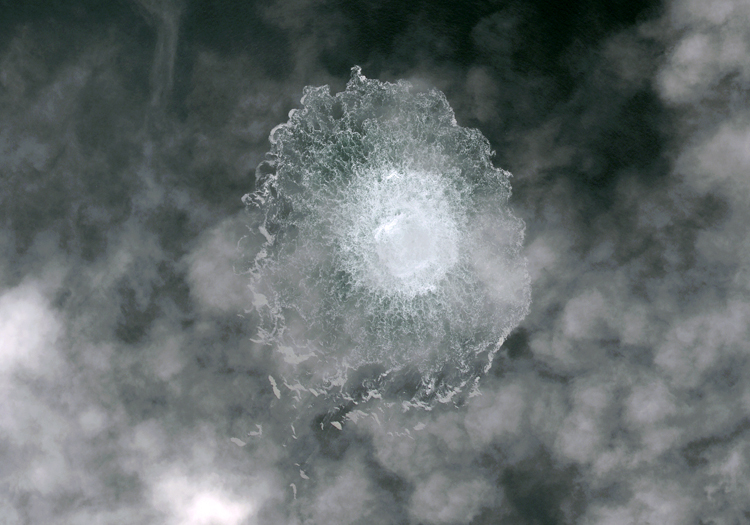
This year, the BRICS will enlarge with Saudi Arabia, Iran, UAE, Egypt, Ethiopia and Argentina joining. It has some of the largest producers and consumers of oil. A commodity backed BRICS currency is on the works. India is expanding its UPI payment system. Russia, Argentina, Saudi Arabia, Brazil, Iraq and Thailand are amongst countries increasingly accepting Yuan for bilateral trade settlements. As the US dollar loses its stranglehold as world's reserves currency, the American house of cards may crumble underneath its $34 trillion debt. With that will go its capacity to finance its ruinous wars.





